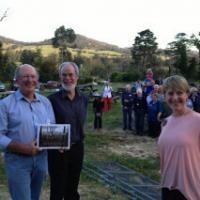‘Black’ days of bushfire


February is the height of the bushfire season in southern Australia and a month that haunts us with the threat and memory of great fires. Canberrans have just reflected on the ten years since 18 January, 2003, when bushfire roared into the national capital. There are enough ‘Black’ days in modern Australian history to fill up a week several times over – Black Sundays, Mondays, Tuesdays, Thursdays, Fridays and Saturdays – and a Red Tuesday too, plus the grim irony of an Ash Wednesday. Yet we keep being taken unawares.
There is something personal about fire, something frighteningly irrational and ultimately beyond our comprehension. It roars out of the bush and out of our nightmares. It makes its victims feel hunted down and its survivors toyed with. Why did the fire destroy the house next door and leave mine unscathed? As one bushfire survivor has confessed: ‘I felt as if the fire knew me.’ A book about the 2003 Canberra fires took as its title a child’s question: How did the fire know we lived here? The great international fire historian Stephen Pyne keeps telling us that fire ‘isn’t listening to the rhetoric, the research, or the parliamentary resolutions. It doesn’t feel our pain. It doesn’t care. It just is.’ Why does he need to reassure us of this?
February has been seared into Australian consciousness by the Black Saturday fires of 2009. On the morning of 7th February that year, after a protracted drought and weeks of record temperatures, the state of Victoria faced warnings of extreme fire danger. The state’s Premier made public announcements, the Country Fire Authority prepared to enact a disaster plan and residents of fire-prone regions were asked to consider their ‘leave early or stay and defend’ options. By the evening Victoria’s nightmare had been realised. The worst bushfires in the nation’s history had swept through 4,500 square kilometres of land, claiming 173 human lives, injuring 5,000 people, killing countless animals and destroying 2,029 homes.
The Black Saturday fires in Victoria, according to the fire ecologist Kevin Tolhurst, released energy equivalent to fifteen hundred times that of the atomic bombs dropped on Hiroshima. Of the 173 people killed on Black Saturday, two-thirds died in their own homes. Of those, a quarter died sheltering in the bath. There were relatively few injuries: the annihilation was total, and the day after brought an awful stillness and silence. The wind change was a killer, but if it had not arrived when it did the Kilmore East fire might have swept into the thickly vegetated and populated suburbs of Melbourne’s north-east.
Since those fires, historians in the School of History at ANU have been working with the people of Steels Creek in the Yarra Valley, a community that lost ten lives and two-thirds of its homes. The historical research project is now approaching completion and has resulted in two books and a film. The first book, called Living with Fire and written by Christine Hansen and Tom Griffiths, was launched in the valley in November 2012. It is a microcosmic study of the social and environmental history of fire in Australia, and a parable of Australian settlement. A three-minute film about the book can be found at: http://www.youtube.com/watch?v=0G6l4qMKfgA&feature=youtu.be
Later in 2013, a book by Professor Peter Stanley entitled Black Saturday at Steels Creek will be published by Scribe, and a film by Moira Fahy will be released through her film production company One Thousand Productions. Peter’s book, based on extensive interviews and local research, analyses the human experience of Black Saturday in this corner of the Yarra Valley and provides a case study of how people in an Australian bush community responded to such a crisis. Moira’s 60 minute DVD captures, over a period of three years, the trauma and recovery of three families from the Steels Creek community as they rebuild their lives after Black Saturday.
The books and the film together try to answer the three questions that haunted the survivors of Black Saturday: What happened on the day of tragedy? How will they recover and re-invent their futures? What does it mean to live with fire?
Tom Griffiths is the W K Hancock Professor of History in the School of History, Research School of Social Sciences, and Director of the Centre for Environmental History at ANU.









